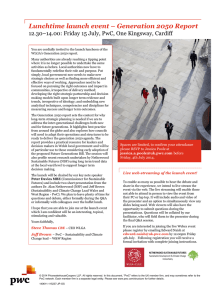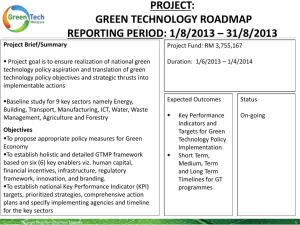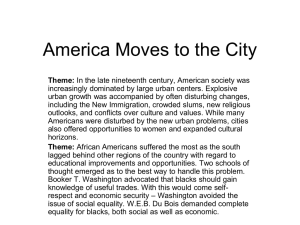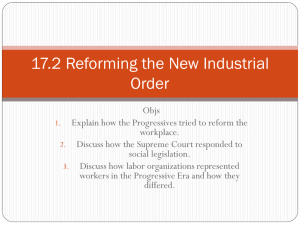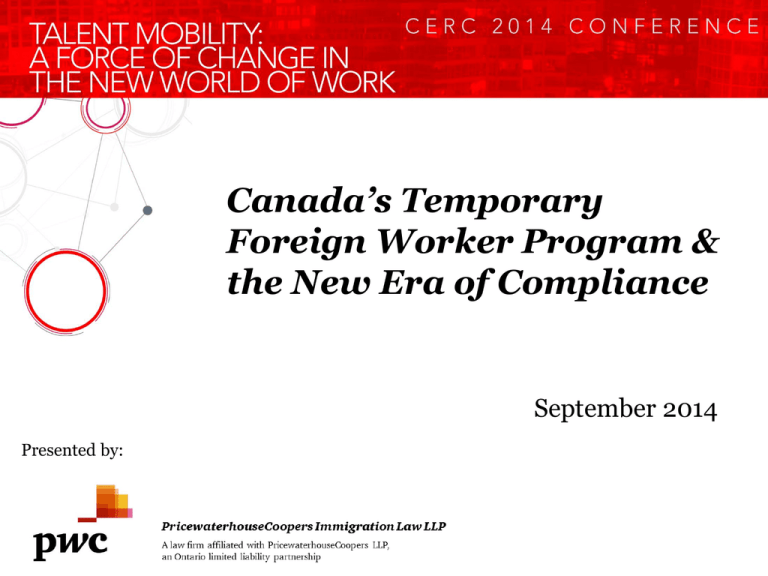
Canada’s Temporary
Foreign Worker Program &
the New Era of Compliance
September 2014
Presented by:
Overview
• Why Immigration? The Modern Mobility Movement
• The Business Visitor
•
When is a work permit required?
•
Taxation considerations for business visitors
• The Work Permit Process
•
Recent Changes to Canada’s Temporary Foreign Worker Program
•
Taxation considerations for workers
• Strategies for Ensuring Compliance
PwC
Why immigration?
Modern mobility
1970–1990
• Majority of moves are outbound
from US- and European-based large
multinationals
• Oil, gas and mining send talent to
more remote locations
• Typically 2 to 5 year assignments
• Rich, attractive expatriate package,
with government incentives to
promote immigration
PwC
4
Modern mobility
1990–2010
• Global Mobility increases – New
markets to sell to, lower-cost
production locations, offshoring
gathers pace
• More commuter and project-based
assignments, as well as business
traveller arrangements
• Global governance, managing costs
and compliance becoming
increasingly difficult
• Economic downturn results in
immigration changes for political
scoring
• Impact of global security threats,
terrorism
PwC
5
Modern mobility
Fast-forward to 2020
• Global Mobility volumes increase –
The number of ‘host’ locations an
organization deals with expected to
grow by 50% between 2010 and
2020, from an average of 22 to 33
• Organizations expect management
of Global Mobility to be part of the
new ‘normal’ for HR and tax
professionals
• Mobility of talent is fluid; it enables
global growth, resourcing, talent
and succession planning strategies
• Multinationals become true
global entities
PwC
6
Modern mobility
32%
46%
63%
of CEOs are concerned
about new market
entrants
44%
of CEOs are concerned
about the availability of
key skills
of CEOs say creating a
skilled workforce is a
priority for their company
over the next 3 years
of CEOs are or have
implemented changes to
their talent strategies
81%
of CEOs believe
technological advances will
most transform their
business over next 5 years
Source: PwC 17th Annual Global CEO Survey, 2014
PwC
7
Real world example: Janet Doe
Scenario #1:
Janet, a U.S. citizen, has spent the last three years living in India and
working for Co. India. She has been offered a 3-year secondment to
Canada to work at Co. India’s parent company, Co. Canada.
Scenario #2:
Janet has been requested to provide supervision on a project in Canada
over the next 6 months. During this time, she will enter periodically but
only for a couple days at a time.
What immigration questions does Janet’s employer need to ask?
What are the relevant tax considerations?
PwC
8
To be or not to be…
a Business Visitor
Business Visitor
Who is a Business Visitor?
• In limited instances, individuals may enter Canada or the US for work or
business without requiring a work permit. “Business Visitors” must undergo
examination and demonstrate they will:
o
maintain their primary place of residence outside of the host country
o
maintain their primary source of remuneration for the business activities outside
of the host country
o
maintain their principal place of business and actual place of accrual of profits
outside of the country of destination
o
be entering for the sole purpose of engaging in international business activities
• All business visitors must undergo examination either at the port-of-entry or
visa post (if applying for a TRV)
PwC
10
Business Visitor
Business visitor activities defined
• Attending meetings (for discussions only)
• Conducting research for a foreign-based enterprise
• Conducting commercial transactions on behalf of a foreign
enterprise; i.e. discussions and negotiations respecting the sale,
purchase, marketing, etc. of goods or services
• Sales representatives taking orders for goods or services for a foreign
enterprise, or purchasing goods or services for a foreign enterprise
PwC
11
Business Visitor
Business visitor activities defined
• Transportation operators transporting goods
or passengers
• Attending or participating in conventions or
conferences
• Intra-company training (in Canada)
• After-sales services (pursuant to a contract)
PwC
12
Business Visitor: Taxation considerations
Resident vs. Non-Resident
• Living in Canada
• Family and home in Canada
• Visiting Canada
• Business trips and meetings
• Deemed Resident
• Greater than 183 days
PwC
13
Business Visitor: Taxation considerations
Treaties
• Permanent home: Purchased or rental
• Personal economical ties: Center of vital interests
• 183 day test: 12 month vs. calendar
• Remuneration borne by or a permanent establishment (PE) of
• Or on behalf of, who is benefiting from the employment?
• Deemed PE
• Regulation 102 Requirements
PwC
14
Real world example: Janet Doe
Business Visitor
Q: Could Janet enter Canada as a Business Visitor?
Q: Would Janet be subject to tax?
Q: What is her employer’s responsibility?
PwC
15
The work permit process
When is a work permit required?
Regardless of the country of destination, a work permit is almost always
required where a foreign national will be entering the local labour
market
Definition of “work”:
• An activity for which wages or commissions are earned, or
• An activity that competes directly with activities of citizens or
permanent residents in the labour market
PwC
17
The work permit process
Canada’s Temporary Foreign Worker Program has
been reorganized into two distinct programs:
1
Temporary Foreign Worker Program
2
PwC
International Mobility Program
18
The new Temporary
Foreign Worker Program
Temporary Foreign Worker Program
Objective: Last resort for employers to fill jobs for which qualified
Canadians are not available
• Managed by Employment and Social Development Canada (ESDC)
• Based on employer demand to fill specific jobs
• Employer must pass new Labour Market Impact Assessment
(replacing the former Labour Market Opinion)
• Unilateral and discretionary
• No reciprocity
• Results in employer-specific work permits
PwC
20
Temporary Foreign Worker Program (TFWP)
Labour Market Impact Assessment (LMIA)
General process for obtaining a work permit includes a 2-stage process:
PwC
1
Employer applies for an LMIA from ESDC / Service
Canada
2
Foreign worker applies for a work permit from CIC
21
TFWP – Labour Market Impact Assessment
The LMIA process
•
ESDC has restructured the TFWP and process for assessing labour market impact with
the introduction of 5 streams based on wage level and occupation type
Occupations at/above
the provincial/
territorial median wage
Low Wage
Occupations below the
provincial/territorial
median wage
PwC
High Wage
No change to stream for
live-in caregivers
Primary
Agricultural
Replacing Seasonal
Agricultural program
Live-In
Caregivers
Highest
Demand,
Highest Paid,
Shortest
Duration
*New* stream to
facilitate LMIAs for
certain occupations
22
TFWP – Labour Market Impact Assessment
Median hourly wages by province*
Province
Wage ($/hr)
Newfoundland and Labrador
20.19
Prince Edward Island
17.26
Nova Scotia
18.00
New Brunswick
17.79
Quebec
20.00
Ontario
21.00
Manitoba
19.00
Saskatchewan
21.63
Alberta
24.63
British Columbia
21.79
*as of August 2014 – median wages for all provinces and territories available at ESDC’s website
PwC
23
TFWP – Labour Market Impact Assessment
Low wage stream
•
Positions where salary offered falls below the provincial/territorial median wage,
including general labourers, food counter attendants, sales, and service personnel
Cap on low-wage temporary foreign workers
•
Employers with 10 or more employees will be subject to cap of 10% of their total
workforce at each worksite may consist of temporary foreign workers
Reducing work permit duration
•
Maximum duration granted will be reduced from 2 years to 1 year
Areas of high unemployment
•
PwC
LMIAs will not be approved for occupations in the non-tradeable services
(accommodation, food services, and retail trade) in regions with an unemployment
rate of 6% or higher
24
TFWP – Labour Market Impact Assessment
High wage stream
•
Positions at or above the provincial/territorial median wage, including managerial,
scientific, professional and technical positions
•
Minimum recruitment efforts and prevailing wage requirements must be met
New transition plan requirements
•
PwC
Transition plan must be provided to demonstrate how the employer will increase
efforts to hire Canadians, and reduce their reliance on temporary foreign workers
•
Proof of investment in skills training, hiring Canadian apprentices, more active
recruitment efforts from within Canada, or transitioning temporary foreign
workers to Canadian permanent residence
•
Report on progress/success of transition plan must be provided with
applications to extend LMIA/work authorization; compliance reviews
25
TFWP – Labour Market Impact Assessment
Highest-demand, Highest-paid, Shortest-duration
LMIA processing times of ten (10) business days or less!
Highest-Demand
•
Skilled trades where the wage offered is at or above the provincial/territorial median
wage; additional occupations may be added at a later date
Highest-Paid
•
Highest-paid occupations, where prevailing wage is in the top 10% of wages earned by
Canadians in a given province or territory (i.e. physicians)
Shortest-Duration Occupations
•
PwC
Temporary foreign workers entering for 120 calendar days or less where wages offered
are at or above the provincial/territorial median (i.e. technical specialists entering for
repair or warranty work); renewals will not be permitted
26
TFWP – Labour Market Impact Assessment
LMIA – wage requirements
Prevailing wage
•
Companies must pay at least the prevailing wage as reported on Service Canada’s
reports at the time of application for all positions
•
Prevailing wage is calculated based on the NOC code, and should be considered in all
advertising efforts
•
Wage reports available on Service Canada’s website, and updated regularly:
www.workingincanada.gc.ca
Source of pay
•
Key factor in determining “employer” for LMIA
•
Consideration for taxation and payroll purposes
PwC
27
TFWP – Labour Market Impact Assessment
LMIA – Advertising requirements
Where?
•
Canadian Job Bank (or territorial/provincial equivalent); and
•
Two or more additional but distinct methods of recruitment consistent with the normal
practice for the occupation, one of which must be national in scope
How long?
•
Employers must advertise available positions in Canada for at least four (4) weeks
before applying for an LMIA
•
The advertisement must remain posted to actively seek qualified Canadians and
permanent residents until the LMIA is issued
PwC
28
TFWP – Labour Market Impact Assessment
LMIA – Other considerations
Increased Fees
• The LMIA fee increased from $275 to $1,000 for every temporary foreign
worker position requested by an employer
• New $100 privilege fee on employers applying for LMIAs to offset the costs
of Government of Canada investments in skills and job training
New Forms and Attestations
• Employers must attest that they cannot lay off or reduce hours of Canadians
where TFWs are employed
Public Lists
• Employers who engage in the TFWP will have their names and number of
LMIAs obtained posted on the ESDC website
PwC
29
The new International
Mobility Program
International Mobility Program
Objective: To advance Canada’s broad economic and cultural
national interest
• Managed by Citizenship and Immigration Canada (CIC)
• Based largely on reciprocity and multi/bilateral agreements with
other countries (NAFTA, GATS)
• No Labour Market Impact Assessment required
• Largely for high-skilled, high-wage occupations
• Results in either open or employer-specific work permits
PwC
31
International Mobility Program
•
Examples of LMIA-exempt work permit categories under the International Mobility
Program (IMP) include:
Intracompany
transfers
IEC /
Working
holiday
Postgraduate
work permit
NAFTA
professional
IMP
Bridging
open work
permit
Emergency
repair
Spousal
work permit
PwC
Reciprocal
employment
32
International Mobility Program
Intra-company transferees
Who may qualify?
• Citizens of all countries
• Senior managers, executives, or specialized knowledge workers
• Current employee of foreign enterprise
Requirements
• Employee must have been employed by overseas parent, subsidiary,
affiliate or branch for at least 1 year in the last 3 years
• Both foreign and host companies must be related and be permanent and
continuing establishments
• Entering for a temporary period, to work on behalf and for benefit of host
company
PwC
33
International Mobility Program
Intra-company transferees
New threshold for “specialized knowledge”
• Effective June 2014, CIC officers will now apply a more rigorous test for
specialized knowledge, focusing not only on the applicant’s degree of
proprietary knowledge, but also their advanced expertise and
experience within the company and industry
• Specialized knowledge is:
◦ unique and uncommon
◦ held by only a small percentage of employees within a company
◦ critical to the company’s operations; held by key personnel
◦ held by specialists; more than just highly skilled staff
◦ remunerated accordingly
• Specialized knowledge workers should not require any training in Canada
PwC
34
International Mobility Program
Intra-company transferees
Mandatory Wage Floor
• Employers must now demonstrate that they
pay their specialized knowledge workers a
salary meets or exceeds prevailing wage in
Canada
• Non-cash per diems cannot be included in the
calculation of the overall wage
• Special exception specialized knowledge ICTs
entering Canada pursuant to an international
free trade agreement, including NAFTA
PwC
35
International Mobility Program
Open work permits
•
Some LMIA exemptions allow for foreign nationals to apply for open work
permits, including under the IEC, post-graduate, spousal, and bridging open
work permit categories
New fees
•
CIC will be imposing a $100 privilege fee on holders of open work permits
•
The funds collected will be used to provide information to foreign nationals and
their employers to promote the transition to permanent residence through the
new Express Entry system, expected to be rolled out in 2015
PwC
36
Dependents – New rules
New definition of “dependent”
• Dependent children may be eligible for status in Canada on the basis of their
parents’ work permit or permanent residence
• Effective August 1, 2014, in order to qualify as a “dependent child”,
children must be:
o
Under 19 years of age; or
o
Financially dependent due to a physical or mental condition
•
With the new changes, the exception to the age limit of dependent children
for full-time students will be removed
•
Children aged 19 or above will need to qualify for status on their own merits
PwC
37
Work Permits and tax considerations
Canadian source wages
• A day is a day
• 10 work days in Canada, 10/240 x base
• Lump sum payments
• Relocation allowances etc
• Housing, cost of living
• Temporary workers, tax free housing, per diems
• Prior year earnings
• Bonus source base on prior year
• Long term incentive payments
• Stock options, RSUs, etc
PwC
38
Real world example: Janet Doe
Work Permit Process
Q: Under which program should Janet be submitting her
immigration application: TFWP or IMP?
Q: If Janet remains on Indian payroll, what considerations must the
company keep in mind? How will that impact immigration? Tax?
PwC
39
Ensuring compliance
Ensuring compliance
Increased emphasis on immigration compliance
•
2011 - Changes to regulations placed increased scrutiny on employers
•
2012 – Introduction of employer compliance reviews and increased penalties
•
2013 – Increased authority to conduct on-site inspections
•
2014 – Increased enforcement and implementation of employer penalties
•
Increased focus on payroll reporting
PwC
41
Ensuring compliance
Impact on the company
Imprisonment
Civil litigation
Monetary fines (ranging up to
$100,000)
Company name published on publicly
available blacklist
Bar from hiring any foreign workers across
Canada for up to 2 years
PwC
42
Ensuring compliance
Impact on the employee
Fines
Arrest and deportation
Bar from applying for future
work permits
Bar from entering the country for either a
set or indefinite period of time
PwC
43
Ensuring compliance
The role of the employer – Bill C-35
• Bill C-35 identifies who, in a paid position, may advise or assist an individual
with any type of immigration process or application under the Immigration
and Refugee Protection Act (IRPA)
• Authorization extends to lawyers, licensed paralegals, and immigration
consultants in good standing
• CIC has confirmed:
1. “Authorization” does not extend to HR personnel or other paid
employees of the individual’s employer
2. HR personnel can assist with LMO applications only
3. HR is prohibited from providing immigration advice and assisting in
preparation of immigration applications
PricewaterhouseCoopers LLP
Immigration Law LLP
44
Ensuring compliance
What do companies need to do? - Immigration
1. Plan Ahead
2. Confirm if a visa, work permit, or LMIA is required
3. Ensure documentation is thorough and complete
4. Track work permit history of all foreign workers
5. Monitor terms and conditions of authorized work
6. Start the permanent residence process early
7. Establish and implement an immigration policy
PwC
45
Ensuring compliance
What do companies need to do? - Taxation
1. Social insurance number vs. individual identification number (ITN)
2. Spouse, children
3. Filing of Canadian return – due April 30th
4. New requirements for reporting foreign assets
5. Withholding
6. T4 reporting
◦ Who’s the employer?
◦ EHT, other payroll taxes
7. Treaty exemption
◦ Waivers
◦ Reporting
PwC
46
Questions?
Speakers
PwC
Melodie Hughes
melodie.hughes@ca.pwc.com
Carola Trolley
carola.trolley@ca.pwc.com
PricewaterhouseCoopers
Immigration Law LLP
PricewaterhouseCoopers LLP
Human Resource Services
Thank you!
This publication has been prepared for general guidance on matters of interest only, and does not constitute professional advice. You should not act
upon the information contained in this publication without obtaining specific professional advice. No representation or warranty (express or implied) is
given as to the accuracy or completeness of the information contained in this publication, and, to the extent permitted by law, PricewaterhouseCoopers
Immigration Law LLP, its members, employees and agents do not accept or assume any liability, responsibility or duty of care for any consequences of
you or anyone else acting, or refraining to act, in reliance on the information contained in this publication or for any decision based on it.
© 2014 PricewaterhouseCoopers Immigration Law LLP. All rights reserved.
PwC

